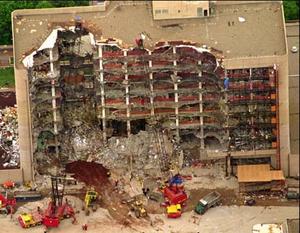Infrastructure protectionSecret bomb-proofing building design posted on the Web
The Pentagon is building two towers in Alexandria, Virginia, to house 6,400 personnel; the Army Corps of Engineers inadvertently posted the bomb-proofing specifications for the new buildings on the Web; experts say this will allow terrorist to learn how to circumvent the building defenses; there is another problem; the documents reveal that the specifications call for the building to be designed to resist threats posed by vehicle bombs detonated outside the building’s security perimeter carrying the equivalent of 220 pounds of TNT; experts say this is not enough; Timothy McVeigh used 4,000 pounds of TNT in Oklahoma City in 1995; the 1993 attempt on the World Trade Center involved 900 pounds; the attack on the Marine barracks in Lebanon in 1983 involved 12,000 pounds of TNT

Damage done by the equivalent of 4,000 pounds of TNT // Source: wordpress.com
The Department of Defense is building a new building in Alexandria, Virginia, planning to house some 6,400 DoD personnel in it. The Pentagon also wanted to make the building bomb-proof. The facility consists of two towers, one of fifteen stories the other of seventeen stories, joined up to the tenth floor.
Trouble is, the bomb-proofing design – a 30-page document accompanied by nearly 400 pages of technical details – was inadvertently posted to the publically accessible Web site of the U.S. Army Corps of Engineers. There is a another problem: Reuters reports that the level of bomb-proofing is astonishingly low: the secret-document stipulates that the building should be designed to resist threats posed by vehicle bombs detonated outside the building’s security perimeter carrying the equivalent of 220 pounds (100 kilograms) of TNT. This is far less than the amount of explosives used in Oklahoma City in 1995 (4,000 pounds, or 1,818 kilograms of TNT), the first attempt on the World Trade Center in 1993 (900 pounds, or 409 kilograms of TNT), or in the attack on the U.S. Marine barracks in Lebanon in 1983 (12,000 pounds, or 5,454 kilograms of TNT).
Reuters also reports that the document remained on the site more than twenty-four hours after the news agency advised the Corps of the security breach. Even after the document was removed from the Web, it could be accessed through a Google cache.
Joanne Hensley, the Army Corps’ deputy project manager for the building, told Reuters that the decision to base the building’s bomb-proofing design elements on the threat posed by a 220-pound bomb was a “judgment call by our experts.”
